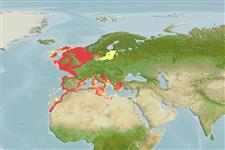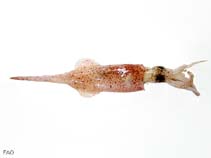Alloteuthis subulata (Lamarck, 1798)
European common squid| Native range | All suitable habitat | Point map | Year 2050 |

|
| This map was computer-generated and has not yet been reviewed. |
| Alloteuthis subulata AquaMaps Data sources: GBIF OBIS |
Classification / Names Common names | Synonyms | CoL | ITIS | WoRMS
Cephalopoda | Myopsida | Loliginidae
Environment: milieu / climate zone / depth range / distribution range Ecology
Demersal; depth range 0 - 630 m (Ref. 101472), usually 20 - 200 m (Ref. 275). Subtropical; 62°N - 20°N, 18°W - 37°E (Ref. 107401)
Distribution Countries | FAO areas | Ecosystems | Occurrences | Introductions
Eastern Atlantic and the Mediterranean: In the northeast Atlantic and Mediterranean between 20° and 60° N.
Length at first maturity / Size / Weight / Age
Maturity: Lm 7.8, range 3 - 12.8 cm Max length : 21.5 cm ML male/unsexed; (Ref. 104052); 15 cm ML (female); max. reported age: 1.00 years (Ref. 275)
Short description Morphology
Juveniles develop a bullet-shaped body, have paddle-shaped terminal fins from a simple point at the tip, and the apex later extends into a tail. Adults are typical myopsid squid, with a long muscular mantle and well-defined fins, fins originate in the posterior mantle and extend to the apex, fin width is at least 25% of ML, longest arm is 20-25% of ML, tentacles are considerably shorter than the head and mantle with narrow clubs that have pairs of central suckers attached obliquely to the club axis at an angle, suckers are biserial on the arms, and in four rows on the narrow tentacular clubs tentacle club arrangement is similar in juveniles and adults with suckers of the median rows 3-4 times larger than those of the marginal rows, median suckers are attached obliquely at a 45 degree angle, left ventral arm (IV) is hectocotylized in mature males, 6-8 pairs of proximal suckers which are unmodified and two distal longitudinal rows of fine papillae.
Max length of female from Ref. 275. Females grow bigger than males (Ref. 3722). Neritic, demersal (Ref. 104428). Common in shallow waters (Ref. 104148). Found in the continental shelf (Ref. 104149), shelf break front (Ref. 122864) and upper/middle slope (Ref. 105634). Recorded in subtidal Zostera marina meadows (Ref. 113974). Mainly feeds on small fish (Ref. 104428), also feeds on amphipods, copepods, decapods, euphausiids and mysids (Ref. 107015). Preyed upon by seabird, marine mammals, fish and squids (Ref. 104428).
Life cycle and mating behavior Maturity | Reproduction | Spawning | Eggs | Fecundity | Larvae
Members of the class Cephalopoda are gonochoric. Male and female adults usually die shortly after spawning and brooding, respectively. Mating behavior: Males perform various displays to attract potential females for copulation. During copulation, male grasp the female and inserts the hectocotylus into the female's mantle cavity where fertilization usually occurs. Life cycle: Embryos hatch into planktonic stage and live for some time before they grow larger and take up a benthic existence as adults (Ref. 833). Males mature earlier than females (Ref. 104428).
Main reference
References | Coordinator | Collaborators
Roper, C.F.E., M.J. Sweeney and C.E. Nauen. 1984. (Ref. 275)
IUCN Red List Status (Ref. 130435)
Data deficient (DD) ; Date assessed: 15 July 2015
CITES status (Ref. 108899)
Not Evaluated
CMS (Ref. 116361)
Not Evaluated
Threat to humans
Human uses
Fisheries: commercial
| FishSource |
Tools
More information
Internet sources
BHL | BOLD Systems | CISTI | DiscoverLife | FAO(Publication : search) | Fishipedia | GenBank (genome, nucleotide) | GloBI | Gomexsi | Google Books | Google Scholar | Google | PubMed | Tree of Life | Wikipedia (Go, Search) | Zoological Record
Estimates based on models
Preferred temperature
(Ref. 115969): 7.4 - 19.4, mean 10.8 (based on 1414 cells).
Resilience
(Ref. 69278):
Medium, minimum population doubling time 1.4 - 4.4 years (K=0.2-0.27; tmax=1).



